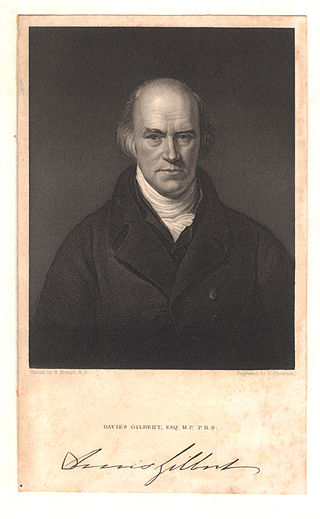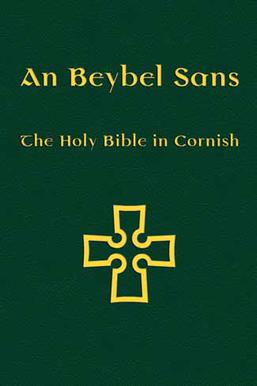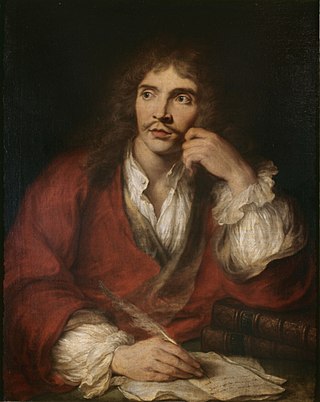
Alexandrine is a name used for several distinct types of verse line with related metrical structures, most of which are ultimately derived from the classical French alexandrine. The line's name derives from its use in the Medieval French Roman d'Alexandre of 1170, although it had already been used several decades earlier in Le Pèlerinage de Charlemagne. The foundation of most alexandrines consists of two hemistichs (half-lines) of six syllables each, separated by a caesura :
o o o o o o | o o o o o o o=any syllable; |=caesura
Cornish is a Southwestern Brittonic language of the Celtic language family. Along with Welsh and Breton, Cornish is descended from the Common Brittonic language spoken throughout much of Great Britain before the English language came to dominate. For centuries, until it was pushed westwards by English, it was the main language of Cornwall, maintaining close links with its sister language Breton, with which it was mutually intelligible, perhaps even as long as Cornish continued to be spoken as a vernacular. Cornish continued to function as a common community language in parts of Cornwall until the mid 18th century, and there is some evidence for traditional speakers of the language persisting into the 19th century.

Le Roman de la Rose is a medieval poem written in Old French and presented as an allegorical dream vision. As poetry, The Romance of the Rose is a notable instance of courtly literature, purporting to provide a "mirror of love" in which the whole art of romantic love is disclosed. Its two authors conceived it as a psychological allegory; throughout the Lover's quest, the word Rose is used both as the name of the titular lady and as an abstract symbol of female sexuality. The names of the other characters function both as personal names and as metonyms illustrating the different factors that lead to and constitute a love affair. Its long-lasting influence is evident in the number of surviving manuscripts of the work, in the many translations and imitations it inspired, and in the praise and controversy it inspired.
Terza rima is a rhyming verse form, in which the poem, or each poem-section, consists of tercets with an interlocking three-line rhyme scheme: The last word of the second line in one tercet provides the rhyme for the first and third lines in the tercet that follows. The poem or poem-section may have any number of lines, but it ends with either a single line or a couplet, which repeats the rhyme of the middle line of the previous tercet.
Nicholas Jonathan Anselm Williams, sometimes credited as N. J. A. Williams, is a leading expert and poet in the Cornish language.

Heroic verse is a term that may be used to designate epic poems, but which is more usually used to describe the meter(s) in which those poems are most typically written. Because the meter typically used to narrate heroic deeds differs by language and even within language by period, the specific meaning of "heroic verse" is dependent upon context.

Breton literature may refer to literature in the Breton language (Brezhoneg) or the broader literary tradition of Brittany in the three other main languages of the area, namely, Latin, Gallo and French – all of which have had strong mutual linguistic and cultural influences.

Cornish literature refers to written works in the Cornish language. The earliest surviving texts are in verse and date from the 14th century. There are virtually none from the 18th and 19th centuries but writing in revived forms of Cornish began in the early 20th century.

Davies Gilbert was a British engineer, author, and politician. He was elected to the Royal Society on 17 November 1791 and served as its President from 1827 to 1830. He changed his name to Gilbert in 1817 and served as Member of Parliament, first for Helston in Cornwall and then for Bodmin.
Nationality words link to articles with information on the nation's poetry or literature.
William Scawen (1600–1689) was one of the pioneers in the revival of the Cornish language. He was a politician who sat in the House of Commons in 1640 and fought for the Royalist cause in the English Civil War.

The Ordinalia are three medieval mystery plays dating to the late fourteenth century, written primarily in Middle Cornish, with stage directions in Latin. The three plays are Origo Mundi, Passio Christi and Resurrexio Domini. The metres of these plays are various arrangements of seven- and four-syllabled lines. Ordinalia means "prompt" or "service book".
Specimens of Middle Cornish texts are given here in Cornish and English. Both texts have been dated within the period 1370–1410 and the Charter Fragment is given in two Cornish orthographies.
William Hals (1655–1737) was a Cornish historian who compiled a History of Cornwall, the first work of any magnitude that was printed in Cornwall. He was born at Tresawsan, in the parish of Merther in Cornwall. Much of his work was never published but was used by other Cornish historians, including Davies Gilbert, Thomas Tonkin, and John Whitaker. Some of his original work is now held by the British Library.

Translations of parts of the Bible into Cornish have existed since the 17th century. The early works involved the translation of individual passages, chapters or books of the Bible. The first full translation of the Bible into the Cornish language was published in 2011. The New Testament and Psalms in another translation went online in 2014.

John Keigwin (1641–1716) was a Cornish antiquary, born at Mousehole, Cornwall. He was a leading member of a group of antiquaries in west Penwith: this group also included John and Thomas Boson, William Gwavas, Thomas Tonkin, William Borlase, Oliver Pender, and James Jenkins of Alverton. His teacher was John Boson. In addition to Cornish and English, Keigwin had a command of the French, Latin, Greek and Hebrew languages.
James Jenkins was a Cornish scholar who left some verses giving moral advice on child raising and marriage in the Cornish language. In his day he was considered a learned scholar of the Cornish language. Little of his work has survived.

The French alexandrine is a syllabic poetic metre of 12 syllables with a medial caesura dividing the line into two hemistichs (half-lines) of six syllables each. It was the dominant long line of French poetry from the 17th through the 19th century, and influenced many other European literatures which developed alexandrines of their own.
The Cornish language separated from the southwestern dialect of Common Brittonic at some point between 600 and 1000 AD. The phonological similarity of the Cornish, Welsh, and Breton languages during this period is reflected in their writing systems, and in some cases it is not possible to distinguish these languages orthographically. However, by the time it had ceased to be spoken as a community language around 1800 the Cornish language had undergone significant phonological changes, resulting in a number of unique features which distinguish it from the other neo-Brittonic languages.

Archæologia Britannica, the first volume of which was published in 1707, is a pioneering study of the Celtic languages written by Edward Lhuyd.











